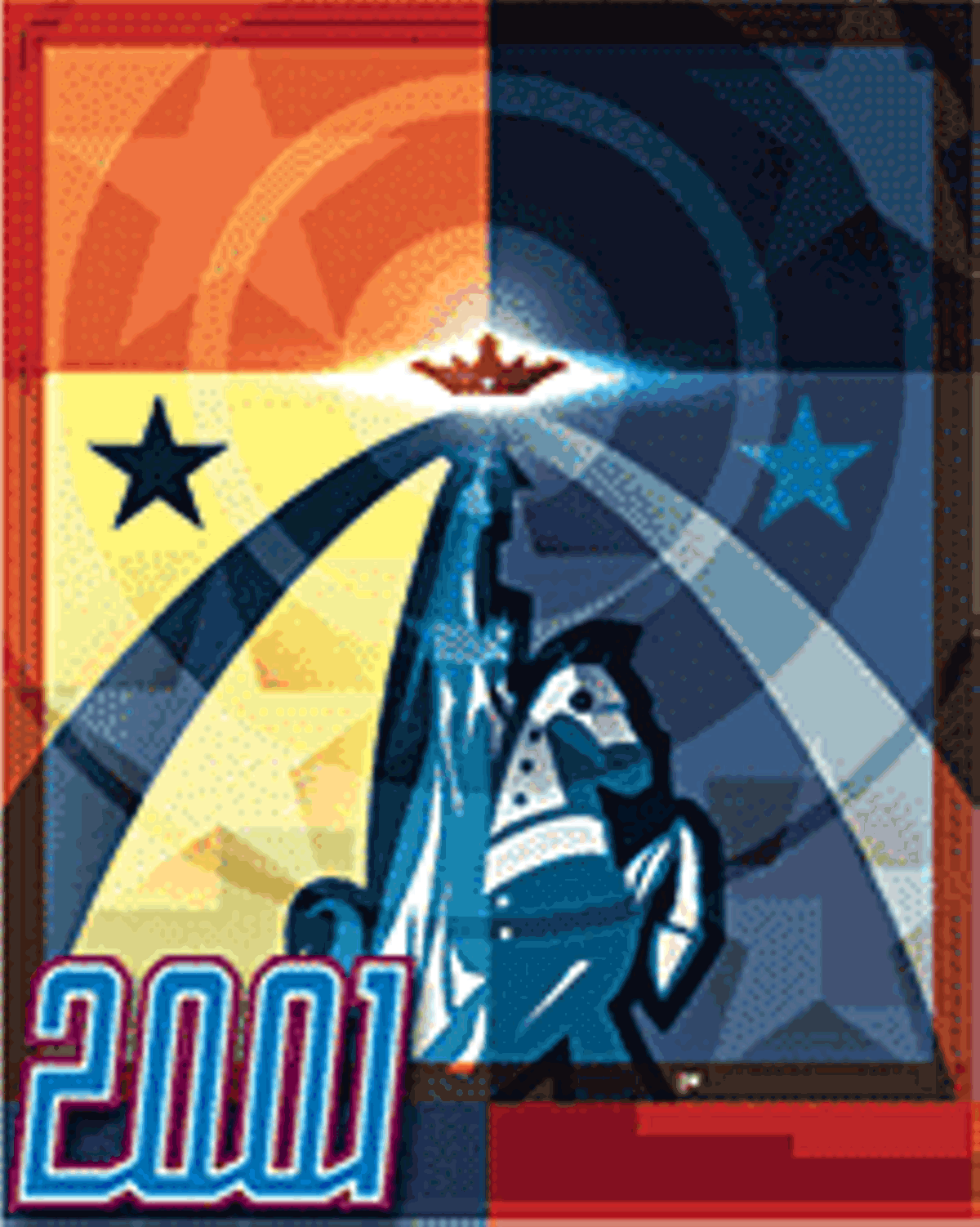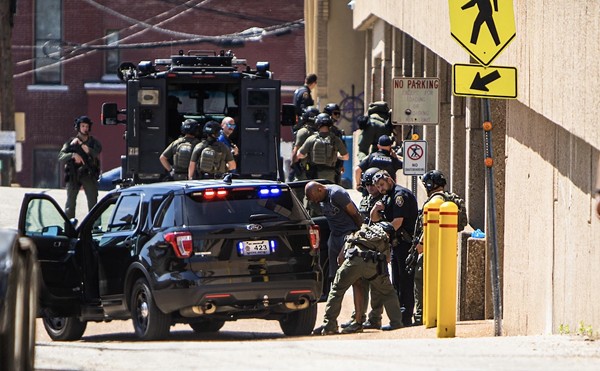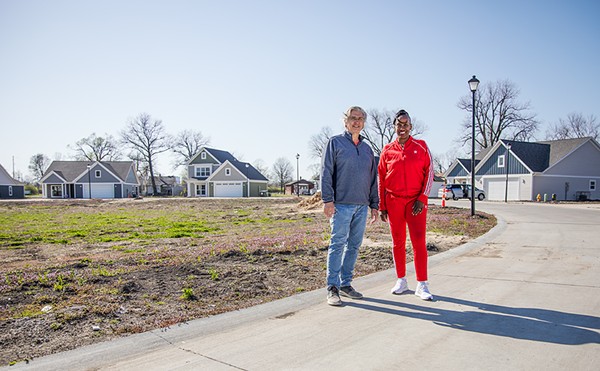Quite frankly, Edwards has seemed, for years now, like the obvious choice and, as such, the least fun to write about. There's not the slightest hint of controversy in the decision, and it's not easy to find anyone who's willing to say anything bad about the guy -- beyond a few disgruntled hipsters, of course, who object on principle to the fact that he's made a lot of money over the past couple of decades and is almost single-handedly responsible for the gentrification of the U. City Loop, an area that was once a lot less shiny and bloated and a great deal more, uh, gritty and bohemian -- which is to say, a little scary and a little sad, much like the areas currently favored by said hipsters. Yeah, gentrification is undoubtedly a double-edged sword. But even his most jaded critics would agree that Edwards has, over the years, made his mark in a consistently classy way.
Edwards' accomplishments begin with Blueberry Hill, the quintessential rock & roll bar-cum-kitsch museum, which he and his wife, Linda, founded in 1972. Between bites of your burger, wander around and check out the Simpsons memorabilia, the Howdy Doody dolls, the vintage posters of baseball greats, the LP covers, the fantastic jukebox, the interesting bathroom graffiti. Pop-culture ephemera, darts, live music downstairs in the Duck Room, witty window displays, food that ranges from decent to inspired -- it's no wonder Blueberry Hill is one of the first places St. Louisans bring out-of-town visitors when we want to prove we don't live in a cowtown. (It is, after all, the readers' choice this year for Best Bar/Nightclub.) Stretching for blocks outside its entrance is the St. Louis Walk of Fame, also Edwards' brainchild, a dignified procession of bronze stars celebrating famous and not-so-famous St. Louis natives (or, in some cases, people who lived here for a while), from Shelley Winters to William Burroughs, from Phyllis Diller to Stanley Elkin, from Auguste Chouteau to Buddy Ebsen, from Tina Turner to Ernest Trova. Follow the trail of stars down Delmar for a couple of blocks, and you'll find the heartbreakingly gorgeous Tivoli Theatre, which Edwards reopened in 1995, after an impeccable, ingenious restoration. (The RFT, whose readers named the Tivoli the Best Movie Theater, is a Tivoli Building tenant.)
But Edwards' crowning achievement resides a few blocks farther east, past U. City's border. There, across the great Skinker divide, in the city of St. Louis, did Edwards his stately pleasure-dome decree, building from the ground up a state-of-the-art music hall, one that offers the best entertainment monster-booking conglomerate Clear Channel can buy. Recently ranked the fifth most successful club nationwide by industry bible Pollstar and the readers' pick as Best Rock & Roll Club, the Pageant is not just St. Louis' pre-eminent midsized concert venue. It's not just a beautiful structure that harmonizes perfectly with the surrounding urban architecture. It's not just a music lover's dream, with its excellent sightlines and thoughtful layout. It's a noble experiment, proof positive that Edwards isn't just a real-estate whiz -- although he's certainly that -- he's also a visionary. Make no mistake: If all Edwards wanted to do was turn a quick buck, he could have chosen a less risky path to tycoondom. The outer reaches of Sprawlsville, studded with prefab strip malls and sterile residential complexes, offer greater financial rewards for the conservative wheeler-dealer. By building his 50,000-square foot, three-story Xanadu just a few blocks east of his home turf, Edwards extends the Loop into the what was once, not so long ago, a bleak urban wasteland and gives the city's revenue-strapped coffers a much-needed boost in the process.
Edwards isn't stopping with the Pageant, though. He's also planning to restore the lovely but neglected church across the street, transforming it into a live-theater venue for local performing-arts troupes. Even more recently, he's made a deal with the Regional Arts Commission, which has outgrown its current home in Grand Center; he's building them a brand-new facility a bit farther east on Delmar. All the while, Edwards is lobbying hard to make state transportation dollars available for a proposed fixed-track trolley system, which would make the nearby MetroLink even more convenient for Loop patrons. Edwards is clearly a man who thinks big -- and none but the most jaundiced naysayer would argue that his efforts won't benefit the region as a whole. In fact, most St. Louisans would probably say that if anyone deserves a bronze star on the Walk of Fame, it's Edwards, whose success as a developer is matched only by his passion for the culture of our city.
His biggest fan is his wife, who describes him as an honorable guy who always holds to his word. When asked what made her fall in love with him, more than 30 years ago, Linda confesses, with a rueful laugh, that it was probably "his stuff": "I spent a week in his apartment. I looked around and thought, 'I really like this guy.' All these little oddball things, quirky stuff -- a Superman lunchbox, things like that -- beautiful furniture from his grandmother and then just junk. A very American mix of stuff -- his love of pop culture and his sensibilities in what he picked and chose."
Even according to less biased sources, Edwards is, if not an actual saint, an entrepreneur of the highest order and a convincing argument for human cloning. (OK, it's illegal and probably unethical, but just imagine if South Grand, if Cherokee, if Midtown had a Joe Edwards!) Tom "Papa" Ray, local blues aficionado and Vintage Vinyl co-owner, calls Edwards a "consistent gentleman who's had a lot of positive influence and who's been a real help to the music scene -- and who's still got his ponytail."
Jill Posey-Smith, a former employee of Blueberry Hill and an occasional RFT contributor, describes Edwards' legacy: "I worked for Joe for 13 years. I watched him build his little empire from a storefront dive to the epic superpower it is today. Having witnessed firsthand how he dealt with floods, bomb threats, earthquakes, power outages, betrayals, politics, partisanship, rock stars and the media, I can only say that I'd feel a lot better if he were running the country right now instead of GWB. Unlike the federal government, I have never known Blueberry Hill to shut down."
Here's to the obvious choice.
Quite frankly, Edwards has seemed, for years now, like the obvious choice and, as such, the least fun to write about. There's not the slightest hint of controversy in the decision, and it's not easy to find anyone who's willing to say anything bad about the guy -- beyond a few disgruntled hipsters, of course, who object on principle to the fact that he's made a lot of money over the past couple of decades and is almost single-handedly responsible for the gentrification of the U. City Loop, an area that was once a lot less shiny and bloated and a great deal more, uh, gritty and bohemian -- which is to say, a little scary and a little sad, much like the areas currently favored by said hipsters. Yeah, gentrification is undoubtedly a double-edged sword. But even his most jaded critics would agree that Edwards has, over the years, made his mark in a consistently classy way.
Edwards' accomplishments begin with Blueberry Hill, the quintessential rock & roll bar-cum-kitsch museum, which he and his wife, Linda, founded in 1972. Between bites of your burger, wander around and check out the Simpsons memorabilia, the Howdy Doody dolls, the vintage posters of baseball greats, the LP covers, the fantastic jukebox, the interesting bathroom graffiti. Pop-culture ephemera, darts, live music downstairs in the Duck Room, witty window displays, food that ranges from decent to inspired -- it's no wonder Blueberry Hill is one of the first places St. Louisans bring out-of-town visitors when we want to prove we don't live in a cowtown. (It is, after all, the readers' choice this year for Best Bar/Nightclub.) Stretching for blocks outside its entrance is the St. Louis Walk of Fame, also Edwards' brainchild, a dignified procession of bronze stars celebrating famous and not-so-famous St. Louis natives (or, in some cases, people who lived here for a while), from Shelley Winters to William Burroughs, from Phyllis Diller to Stanley Elkin, from Auguste Chouteau to Buddy Ebsen, from Tina Turner to Ernest Trova. Follow the trail of stars down Delmar for a couple of blocks, and you'll find the heartbreakingly gorgeous Tivoli Theatre, which Edwards reopened in 1995, after an impeccable, ingenious restoration. (The RFT, whose readers named the Tivoli the Best Movie Theater, is a Tivoli Building tenant.)
But Edwards' crowning achievement resides a few blocks farther east, past U. City's border. There, across the great Skinker divide, in the city of St. Louis, did Edwards his stately pleasure-dome decree, building from the ground up a state-of-the-art music hall, one that offers the best entertainment monster-booking conglomerate Clear Channel can buy. Recently ranked the fifth most successful club nationwide by industry bible Pollstar and the readers' pick as Best Rock & Roll Club, the Pageant is not just St. Louis' pre-eminent midsized concert venue. It's not just a beautiful structure that harmonizes perfectly with the surrounding urban architecture. It's not just a music lover's dream, with its excellent sightlines and thoughtful layout. It's a noble experiment, proof positive that Edwards isn't just a real-estate whiz -- although he's certainly that -- he's also a visionary. Make no mistake: If all Edwards wanted to do was turn a quick buck, he could have chosen a less risky path to tycoondom. The outer reaches of Sprawlsville, studded with prefab strip malls and sterile residential complexes, offer greater financial rewards for the conservative wheeler-dealer. By building his 50,000-square foot, three-story Xanadu just a few blocks east of his home turf, Edwards extends the Loop into the what was once, not so long ago, a bleak urban wasteland and gives the city's revenue-strapped coffers a much-needed boost in the process.
Edwards isn't stopping with the Pageant, though. He's also planning to restore the lovely but neglected church across the street, transforming it into a live-theater venue for local performing-arts troupes. Even more recently, he's made a deal with the Regional Arts Commission, which has outgrown its current home in Grand Center; he's building them a brand-new facility a bit farther east on Delmar. All the while, Edwards is lobbying hard to make state transportation dollars available for a proposed fixed-track trolley system, which would make the nearby MetroLink even more convenient for Loop patrons. Edwards is clearly a man who thinks big -- and none but the most jaundiced naysayer would argue that his efforts won't benefit the region as a whole. In fact, most St. Louisans would probably say that if anyone deserves a bronze star on the Walk of Fame, it's Edwards, whose success as a developer is matched only by his passion for the culture of our city.
His biggest fan is his wife, who describes him as an honorable guy who always holds to his word. When asked what made her fall in love with him, more than 30 years ago, Linda confesses, with a rueful laugh, that it was probably "his stuff": "I spent a week in his apartment. I looked around and thought, 'I really like this guy.' All these little oddball things, quirky stuff -- a Superman lunchbox, things like that -- beautiful furniture from his grandmother and then just junk. A very American mix of stuff -- his love of pop culture and his sensibilities in what he picked and chose."
Even according to less biased sources, Edwards is, if not an actual saint, an entrepreneur of the highest order and a convincing argument for human cloning. (OK, it's illegal and probably unethical, but just imagine if South Grand, if Cherokee, if Midtown had a Joe Edwards!) Tom "Papa" Ray, local blues aficionado and Vintage Vinyl co-owner, calls Edwards a "consistent gentleman who's had a lot of positive influence and who's been a real help to the music scene -- and who's still got his ponytail."
Jill Posey-Smith, a former employee of Blueberry Hill and an occasional RFT contributor, describes Edwards' legacy: "I worked for Joe for 13 years. I watched him build his little empire from a storefront dive to the epic superpower it is today. Having witnessed firsthand how he dealt with floods, bomb threats, earthquakes, power outages, betrayals, politics, partisanship, rock stars and the media, I can only say that I'd feel a lot better if he were running the country right now instead of GWB. Unlike the federal government, I have never known Blueberry Hill to shut down."
Here's to the obvious choice.







